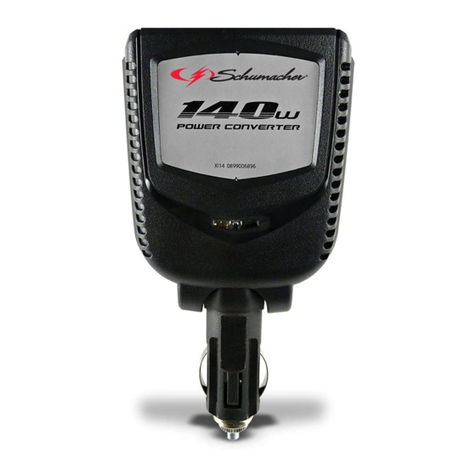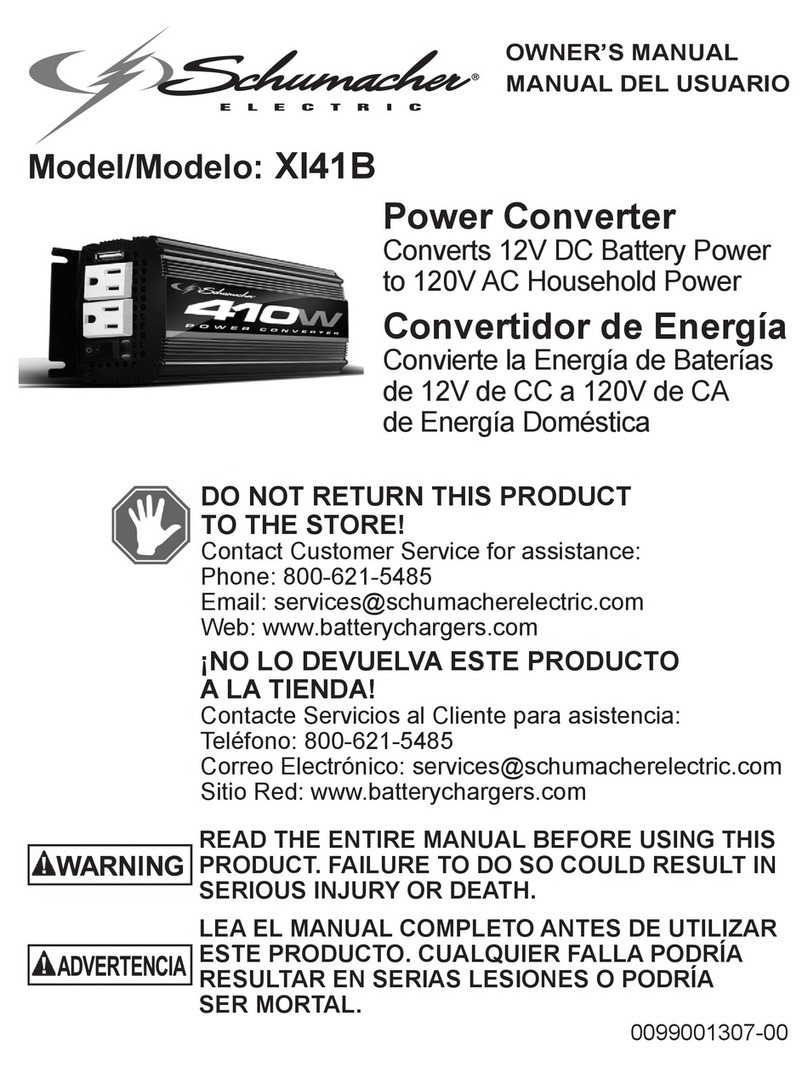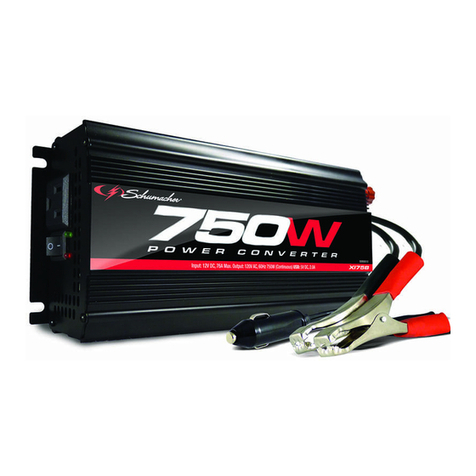Schumacher SI1000 User manual

0099001836-00
PLEASE SAVE THIS OWNERS MANUAL AND READ BEFORE EACH USE.
This manual will explain how to use the converter safely and effectively. Please
read and follow these instructions and precautions carefully.
POR FAVOR CONSERVE ESTE MANUAL DEL USUARIO Y LEALO ANTES
DE CADA USO. En este manual le explica cómo utilizar el convertidor de manera
segura y conable. Por favor, lea y siga las siguientes instrucciones y precauciones.
MODEL / MODELO:
SI1000
Power Converter
Converts 12V DC Battery Power to AC Household Power
Convertidor de Energía
Convierte la energía 12V CD de baterías a energía
doméstica de CA
OWNERS MANUAL
MANUAL DEL USUARIO

•2•
1. IMPORTANT SAFETY INSTRUCTIONS
SAVE THESE INSTRUCTIONS.
1.1 SAVE THESE INSTRUCTIONS.
This manual contains important safety
and operating instructions for converter
model SI1000.This manual will show
you how to use your converter safely and
effectively. Please read, understand and
follow these instructions and precautions
carefully.
WARNING: RISK OF ELECTRIC
SHOCK OR FIRE.
1.2 WARNING: People with pacemakers
should consult their physician before
using the converter. Electromagnetic
elds in close proximity to a heart
pacemaker may cause pacemaker
interference or pacemaker failure.
1.3 IMPORTANT: Do not use in a marine
application.
1.4 Keep out of reach of children.
1.5 Do not expose converter to rain or snow.
1.6 Use of an attachment not recommended
or sold by the unit manufacturer may
result in a risk of re, electric shock, or
injury to persons.
1.7 Do not disassemble the unit; take it to
a qualied serviceman when service or
repair is required. Incorrect reassembly
may result in a risk of electric shock or re.
1.8 To reduce risk of electric shock, unplug
unit from outlet before attempting any
maintenance or cleaning. Turning off
controls will not reduce this risk.
1.9 For the most effective use, place the
power converter on a at surface.
1.10 Keep the converter well ventilated, in order
to properly disperse heat generated while it
is use. Make sure there are several inches
of clearance around the top and sides and
do not block the slots of the converter.
1.11 Do not place the converter in areas
such as battery compartments or engine
compartments, where fumes or gases
may accumulate.
1.12 DO NOT operate the converter if you, the
converter, the device being operated or any
other surfaces that may come into contact
with any power source are wet. Water and
many other liquids can conduct electricity,
which may lead to serious injury or death.
1.13 Do not place the converter on or near
heating vents, radiators or other sources
of heat or ammable materials.
1.14 Do not place the converter in direct
sunlight. The ideal air temperature for
operation is between 50° and 80°F.
1.15 Only connect the power converter to a 12V
battery or power supply. Do not attempt to
connect the converter to any other power
source, including an AC power source.
Connecting to a 6V or 16V battery will
cause damage to the converter.
1.16 Do not use with positive ground electrical
systems.
1.17 Make sure the AC plug is tight.
1.18 Do not modify the AC receptacle in any way.
1.19 Do not try extending or otherwise
changing the 12V power cord supplied
with your converter. Make sure the cord
connections are tight.
1.20 Incorrect operation of your converter may
result in damage and personal injury.
WARNING: The converter output is 120V
AC and can shock or electrocute the same
as any ordinary household AC wall outlet.
1.21 Do not use the converter with a product
that draws a higher wattage than the
converter can provide, as this may cause
damage to the converter and product.
1.22 This device does not include an internal
Ground Fault Circuit Interrupter (GFCI).
For GFCI protection, use a Coleman Cable
02822 GFCI outlet, or its equivalent.
2. PERSONAL PRECAUTIONS
2.1 Restrictions on Use: This converter
may not be used with life support devices
or systems. Failure of this converter can
reasonably be expected to cause failure
of that life support device or system, or to
affect the safety or effectiveness of that
device or system.
2.2 Wear complete eye protection and
protective clothing when working
near lead-acid batteries. Always have
someone nearby for help.
2.3 Remove all personal metal items from
your body, such as rings, bracelets,
necklaces and watches. A lead-acid
battery can produce a short circuit current
high enough to weld a ring to metal,
causing a severe burn.
2.4 Never smoke or allow a spark or ame in
the vicinity of the battery or engine.
2.5 WARNING: This product contains one
or more chemicals known to the State
of California to cause cancer and birth
defects or other reproductive harm.

•3•
3. CONVERTER LOCATION
3.1 Never place unit directly above battery;
gases from battery will corrode and
damage the converter.
3.2 Never allow battery acid to drip on unit
when reading gravity or lling battery.
3.3 Do not operate converter in a closed-in
area or restrict ventilation in any way.
4. FEATURES
• ON/OFF rocker switch
• LED indicator
Green indicates Power ON
Red indicates Overload/Interruption
in power
• 12 Volt power cord
• 120V standard AC outlets (2)
• USB port– 5V, 2.0A
• High-speed cooling fan
To keep the converter cool, the fan speeds
up as the load increases. The fan does
not run when the converter is turned off.
• Positive Battery Cable Terminal (Red)
• Negative Battery Cable Terminal
(Black)
• Ground Terminal and ground wire
Grounds converter, to protect against
electrical shock.
• Thermal Protection
When the thermal resistor exceeds
80° C (176° F), the converter shuts
down until it cools off, and then
automatically restarts.
• Surge Protection
When the power input from the
vehicle’s battery exceeds 16 volts, the
converter shuts down. Once the voltage
drops down to less than 14 volts, it
automatically restarts.
• Low-Battery Protection
When the power input from the vehicle’s
battery drops to below 10.5 volts, the
alarm will sound, the red LED will light,
and the converter will shut down.
5. BEFORE USING YOUR CONVERTER
Do not use the converter with a product
that draws a higher wattage than the
converter can provide, as this may cause
damage to the converter and product.
When you turn on a device or a tool that
runs on a motor, the device goes through
two stages:
1. Start Up – Requiring an initial surge
of power (commonly known as the
“starting” or “peak” load).
2. Continuous Operation – Power
consumption drops (commonly known
as the “continuous load”).
The wattage (WATTS) or amperes (AMPS)
can normally be found stamped or printed
on most devices and equipment, or in
the user’s manual. Otherwise, contact
the manufacturer to nd out whether the
device you want to use is compatible with
a modied sine wave.
To calculate the wattage:
Wattage = AMPS x 120 (AC Voltage).
To calculate the starting load:
Starting Load = 2 x wattage.
In general, the startup load of the device
or power tool determines whether your
converter has the capability to power it.
To calculate the continuous load:
Continuous Load = AMPS x 120
(AC Voltage).
IMPORTANT: Always run a test to
establish whether the converter will
operate a particular piece of equipment or
device. In the event of a power overload,
the converter is designed to automatically
shut down.
This safety feature prevents damaging
the converter while testing devices and
equipment within the wattage range of the
converter.
If a device does not operate properly
when rst connected to the converter, turn
the converter ON/OFF switch ON, OFF,
and ON again in quick succession. If this
procedure is not successful, it is likely that
the converter does not have the required
capacity to operate the device in question.

•4•
IMPORTANT: This converter uses a
modied sine waveform (diagram A)
which is not quite the same as power
company electricity (diagram B). For the
following devices, we strongly recommend
that you use caution and check the
device’s manual to make sure it is
compatible with modied sine waveform.
1. Switch mode power supplies
2. Linear power supplies
3. Class 2 transformers
4. Line lter capacitors
5. Shaded pole motors
6. Fan motors
7. Microwave ovens
8. Fluorescent and high intensity lamps
(with a ballast)
9. Transformer less battery chargers
Using the converter with any of these
devices may cause the device to run
warmer or overheat.
Modied sine waveform
produced by converter
Diagram A
Diagram B
Pure sine waveform
typical of home AC outlet
IMPORTANT: If you are using the
power converter to operate a battery
charger, monitor the temperature of the
battery charger for about 10 minutes.
If the battery charger becomes
abnormally warm, disconnect it from
the converter immediately.
6. FASTENING THE CONVERTER TO A FLAT SURFACE
For your convenience, the converter may
be fastened horizontally to a at surface.
The area where the converter is to be
fastened must be dry, well-ventilated
and away from any combustible material
or fumes.
1. Turn off and disconnect the converter.
2. Place the back of the converter with
the mounting bracket against a at,
secure surface.
3. Attach the converter, using corrosion-
resistant screws.
7. CONNECTING CONVERTER CABLES
The converter and power source must be
in the OFF mode.
IMPORTANT: Make sure to connect your
converter only to a 12 volt power supply.
To avoid electrical shock, it is necessary
to ground the converter as well as the
device powering it. The converter should
be grounded, using a 16 AWG copper
wire (included).
NOTE: Do not turn on the converter or the
power source until the converter and the
power source are grounded.
TO GROUND THE CONVERTER
1. Turn off and disconnect the converter.
2. Locate the chassis ground screw on
the back of the converter.
3. Remove the outer hex nut and loosen
the second hex nut.
4. Attach the grounding wire’s ring
connector to the ground terminal of
the converter.
5. Tighten the hex nut securely. Then,
replace the other hex nut and tighten
it securely.
6. Attach the other end of the wire to a
properly grounded location:
Vehicle: Connect to the chassis, unpainted
frame part, or engine block of the vehicle.
Fixed location: Connect to a ground rod
or other appropriately rated ground.
CONNECTING CONVERTER CABLES
TO THE CONVERTER
1. Locate the Positive and Negative
plastic terminals on the right side of
the converter and remove the terminal
caps completely.
2. Install the POSITIVE (RED) cable ring
lug onto the POSITIVE (RED) terminal
screw. Install the NEGATIVE (BLACK)
cable ring lug onto the NEGATIVE
(BLACK) terminal screw. Tighten each
terminal so that the cable cannot
come loose.

•5•
CONNECTING THE CONVERTER
CABLE TO A 12V BATTERY OR
12V POWER SOURCE:
1. Keep hands, hair, clothing and jewelry
clear of battery terminals.
2. Wear eye protection and protective
clothing.
3. For a negative-grounded vehicle
(do not use with positive ground
electrical systems), connect the
POSITIVE (RED) ring terminal from the
converter to the POSITIVE (POS, P, +)
ungrounded post of the battery. Connect
the NEGATIVE (BLACK) ring terminal
to the vehicle chassis or engine block
away from the battery. Do not connect
the terminal to the carburetor, fuel lines
or sheet-metal body parts. Connect to a
heavy gauge metal part of the frame or
engine block.
4. To disconnect the converter, remove
rst the negative terminal and then the
positive terminal.
IMPORTANT: Failure to make the correct
connections will result in blown fuses and
permanent damage to the converter.
8. BATTERY BANK INSTRUCTIONS
BATTERY BANK ASSEMBLY
WARNING: Read these safety
instructions before assembling the
battery bank.
• Connect batteries ONLY in parallel
(negative terminals together to one
cable; positive terminals together
to the other cable), as shown in the
Battery Bank Example.
• Do not connect 12V batteries in a
series with the negative of one battery
connected to the positive of the next.
DANGER: CONNECTING INCORRECTLY
MAY RESULT IN VOLTAGE HIGH
ENOUGH TO CAUSE ELECTROCUTION.
• While assembling the battery bank, wear
splash-resistant ANSI-approved safety
goggles and electrically insulated gloves.
• Connect ONLY similar batteries together
in a battery bank. Do not connect old
to new, ooded to gel cells, or batteries
with different capacities.
• Use extension cables with the specied
gauge (or thicker).
6' or less: 6 AWG; 6-10': 4 AWG
WARNING:
RISK OF EXPLOSIVE GASES.
• Assemble the battery bank in a clean,
well-ventilated location, away from
ignition sources and ammable materials.
• To reduce risk of battery explosion,
follow these instructions and those
published by the battery manufacturer and
manufacturer of any equipment you intend
to use in vicinity of a battery. Review
cautionary markings on these products.
CONNECTING THE BATTERIES
IN PARALLEL
1. First, connect all of the positive
terminals to each other.
2. Next, connect all of the negative
terminals to each other.
3. Connect the negative and positive
output cables to opposite ends of
the bank. Do not allow the output
cables to touch one another.
4. Test the voltages at the output cables,
to make sure that the battery bank is
correctly wired.
5. If the voltage is higher than 13 volts,
part of the battery bank is probably
connected in series (a negative
terminal of one battery attached to
a positive terminal of another) instead
of in parallel.
6. Carefully examine the diagram and
correct the wiring before attaching to
the converter.
7. Make sure the converter’s switch is
set to OFF (O).
8. Connect the output cables from the
battery bank to the converter.
12V
lead-acid
battery
200 Ah*
Connect additional
12V 200 Ah*
lead-acid
batteries here
to increase capacity
12V
lead-acid
battery
200 Ah*
-
+
+
-
+
-
Example:
12V/400 Ah† BATTERY BANK
OUTPUT
to NEGATIVE
converter
terminal
OUTPUT
to POSITIVE
converter
terminal
†Bank Capacity =
(single battery capacity) x (# of batteries)
400 Ah capacity is for (2) 200 Ah batteries.
*200 Ah batteries shown for illustration
purposes.
Table of contents
Languages:
Other Schumacher Media Converter manuals
Popular Media Converter manuals by other brands

H&B
H&B TX-100 Installation and instruction manual

Bolin Technology
Bolin Technology D Series user manual

IFM Electronic
IFM Electronic Efector 400 RN30 Series Device manual

GRASS VALLEY
GRASS VALLEY KUDOSPRO ULC2000 user manual

Linear Technology
Linear Technology DC1523A Demo Manual

Lika
Lika ROTAPULS I28 Series quick start guide

Weidmuller
Weidmuller IE-MC-VL Series Hardware installation guide

Optical Systems Design
Optical Systems Design OSD2139 Series Operator's manual

Tema Telecomunicazioni
Tema Telecomunicazioni AD615/S product manual

KTI Networks
KTI Networks KGC-352 Series installation guide

Gira
Gira 0588 Series operating instructions

Lika
Lika SFA-5000-FD user guide












